The Keihin-Tohoku Line
The longest commuter service in Tokyo
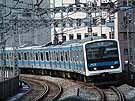 |
|
A series 209 set rolls down an elevated track section in
downtown Yokohama showing its typical commuter train figure, at
Ishikawacho, September 2001.
|
By Hiroshi Naito
Introduction:
The Keihin-Tohoku Line is a common name given for the JR East's EMU
train service running over a route between
Omiya-Ueno-Tokyo-Yokohama-Sakuragicho-Ofuna, a long run of 81.2 km
across the three prefectures of Saitama, Tokyo and Kanagawa. The
service length of 81.2 km is the longest among commuter EMU services in
JR East's territory. There are 46 stations on the route including
historic Ueno, Tokyo, Shimbashi, Kawasaki, Yokohama and Sakuragicho. It
takes more than two hours to travel through the whole length. Its
formal name is the Tohoku Line between Omiya and Tokyo, the Tokaido
Line between Tokyo and Yokohama, and the Negishi Line between Yokohama
and Ofuna. The nature of the service is local trains covering every
intermediate station in the Tokyo metropolitan area and its suburban
areas, particularly on the Omiya to Ueno and Tokyo to Yokohama
sections, as opposed to longer-distance trains of the Tokaido Line and
Tohoku Line that do not stop at most of these stations. The southern
section of the service is along the Negishi Line, diverging from the
Tokaido Main Line at Yokohama, which goes through Yokohama's downtown
area, heavy industrial area, and then suburban residential area. In
contrast to the historic background of the Tokyo to Sakuragicho
section, the Negishi Line section is quite new, having been extended in
the 60s and the 70s. Now, the line is served solely by a fleet of sleek
10-car 209 series stock, including some sets of a new version of the
series numbered in the 500s. However, the old 72 series, ex-JNR's most
common equipment used for urban EMU service in the Tokyo area, was
dominant on the entire service for a long time after the War until
modern stock of the 103 series was introduced around 1965.
Click here to see a route map of the Keihin-Tohoku Line.
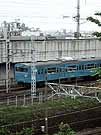 |
|
A 103 series train running through the Oji area in Tokyo. This
set is a later version of the series equipped with air-conditioners and
ATC. Until the introduction of the 209 series, this type used to be
dominant on the service.
February 1992, by Kiyohito Utsunomiya.
|
Background:
The Keihin-Tohoku Line may not seem to have a particularly unique
service compared to other JR's Tokyo area services, but before the
WWII, it used to be the most prominent electric car service among the
Shosen-densha (Note1). It was always on this line when newly developed
stock was put in service. It was served even with a dual-class car
(second class and third class), half of which was a second class
section, which was never seen on other similar lines. The origin of the
Keihin-Tohoku Line service dates back to the electric car operation
between Tokyo Central Station and Takashimacho station in Yokohama
(Note2), which was commenced by Tetsudo-In (Note3) in December 1914.
The service was intended to provide short-distance, frequent service
between Tokyo and Yokohama, on which passenger demands were drastically
increasing. The commencement of the service was dramatic enough with
the usage of the newly built double track segregated from the Tokaido
Line's long distance train tracks also coinciding with the completion
of the new Tokyo Central Station (Note4), reached by extended elevated
tracks from Shimbashi. Actually, the current double track
infrastructure between Tokyo and Yokohama was completed at that time.
The Tetsudo-In was already serving electric car operation on the Chuo
Line between Manseibashi (Note5) and Nakano, and the Yamanote Line
between Gofukubashi (Note6) and Ueno, but unlike these lines, the new
service was epoch-making enough in the technical aspect, with 1200V DC
electrified catenary and pantographs for drawing power as opposed to
trolley wires and poles of the already existing systems. The new stock
put in service used a car body upgrading in length and height, and
operated in two- or three-car formation in Electric Multiple Unit (EMU)
control mode, with propulsion power by 85 kW traction motors on
upgraded bogies. Despite these technological novelties, the service was
reportedly not very successful with many troubles encountered, followed
by an early service suspension. The railway history tells that it was
the May of the next year when the service resumed as a result of the
completion of the improvements concerning the technical issues.
The service segment was extended southwards in December 1915 up to
the current Sakuragicho when the main Yokohama station moved to the
former Takashimacho from Sakuragicho (Note7). In November 1925, as the
elevated tracks between Tokyo and Ueno were completed, the
Toyko-Sakuragicho 'Shosen Densha' service was extended northwards to
Ueno. This was a quite historic milestone for the government railway's
EMU service in the Tokyo area with the commencement of the circular
operation on the Yamanote Loop Line. The Chuo Line's electric car
service was converted to just between Tokyo and Nakano, ceasing through
operation with the Yamanote Line (Note8). The service was soon further
extended northwards to Tabata one month later. The Akabane extension
was completed in February 1928, followed by the full opening of the
service as far as Omiya in September 1932.
The service remained in this route form for a long time through the
War period. After the War, evolution took place at the southern end of
the line in Yokohama. The construction of the Negishi Line progressed
southwards from Sakuragicho, reaching Isogo in May 1964. The Yokodai
extension was completed in March 1970. The line finally reached Ofuna
in April in 1973, completing the current entire service route.
- Note1) Shosen-densha signifies 'the government railway's electric car services', dubbed after Tetsudo-Sho (Railway Ministry).
- Note2) Takashimacho was located between the current Yokohama
station and Sakuragicho station, near the current Tokyu Toyoko Line's
Takashimacho station.
- Note3) Testdudo-In is the former name of Tetsudo-Sho. At his period, the service was called 'Insen-densha'.
- Note4) The current Tokyo station.
- Notw5) Manseibashi is an abandoned station located between Kanda
and Ochanomizu, but the station structure still remains as the
Transportation Museum. The ruin of the island platform at this station
can still be seen on the track above the Transportation Museum even
nowadays.
- Note6) Gofukubashi is an abandoned station located between Tokyo and Yurakucho.
- Note7) The process of the location change of Yokohama station is
complicated. The current Yokohama station is at a third location after
moving from Takashimacho.
- Note8) Before that time, the Yamanote Line was served by through
operation with the Chuo Line encompassing
Nakano-Shinjuku-Kanda-Shinagawa-Shinjuku-Ikebukuro-Tabata-Ueno,
utilizing the already completed elevated tracks between Tokyo and
Kanda.
Change of Line Name:
The service was first called 'Keihin sen', an abbreviation of
Tokyo-Yokohama. As the service extended northwards over the Tohoku Line
section, the line seems to have called as the 'Tohoku-Keihin sen' for a
particular period, but the current 'Keihin-Tohoku sen' was finally
established around the War period. However, the historic name of
'Keihin sen' is still heard even nowadays through the platform
announcement of the Keihin-Tohoku Line at Tokyo station.
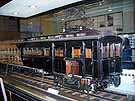 |
|
A cut-away model of Deha 43200 exhibited at the Transportation Museum in Tokyo.
April 2001.
|
Rolling Stock Operated on the Keihin-Tokoku Line:
Among the rolling stock used to run on the Keihin-Tohoku Line, the most
distinctive one was the Deha 43200 series introduced in 1922. This
equipment was powered with four 150HP traction motors and featured
cross-seats for the first time on electric cars of the government
railway (a large cut-away model of this series is still exhibited at
the Transportation Museum, and one can learn through this model that
its appearance including the front appearance leads to that of the
typical modern Shosen-densha stock). At the beginning of the Showa era
around 1925, the technology of the electric cars made significant
progress as to performance and reliability, with the improvement of
multiple unit control and the air brake system. Especially, the
introduction of pneumatic-operated door engines was innovative enough,
allowing simultaneous opening and closing of all doors on a train set,
bringing a great advance on passenger safety. The steel-made car body
was first adapted on the Deha 73200 series (later Moha 30) in 1925. In
1929, the Moha 31 featured a integral curved roof for the first time
rather than the former double roof structure common to rolling stock in
those days. The progress was followed by cars of cross-seats of the
Moha 32 series in 1930 and 20m length class cars in 1931. Around 1935,
the semi-streamlined Moha 60 series appeared. The Keihin-Tohoku Line
was served with this stock together with its variants including the
Kuha 55 and various types of dual-class cars for a long time until the
63 series was introduced during the War period. After the War, the 63
series continued to be mass-produced to meet rapidly increasing
passenger demands that pervaded not only the Keihin-Tohoku Line but
also other EMU-served commuter lines in the Tokyo area, the Yamanote
and the Chuo lines. The poor quality of this series due to the frugal
War time design surfaced when a fire broke out on a 5-car train set of
this series at Sakuragicho in April 1949, killing 106 passengers with
92 seriously injured (this notorious accident is known as the
Sakuragicho incident). Learning a lesson from this incident, this
series was totally improved soon from the safety aspect, and all became
the 72 series.
Various Features:
The symbol colour of the Keihin-Tohoku Line is blue, and stainless
steel built 209 series cars in the fleet are all liveried with two blue
stripes below and above the windows. This symbol colour was established
when 103 series was first introduced in 1965 following the Chuo Line's
orange and the Yamanote Line's green.
In terms of traffic direction, since the line runs through Tokyo
station and Ueno station, the operation is classified as North-bound
and South-bound, as opposed to Up and Down common among other railway
lines in Japan. The Line's operation is most frequent between Akabane
and Kamata, every two minutes at the peak time, with the service
patterns comprising Omiya to Kamata, Omiya to Tsurumi, Omiya to
Sakuragicho, Omiya to Isogo, Omiya to Ofuna, Minami-Urawa to Ofuna and
Akabane to Ofuna. There are a few trains which are terminated at
Higashi-Jujo and Ueno North-bound, and Higashi-Kanagawa South-bound in
the late evening. The southern section in Yokohama from
Higashi-Kanagawa is also served by through trains coming from the
Yokohama Line. Most of the Yokohama Line through trains are terminated
at Sakuragicho, with a few going as far as Isogo and Ofuna.
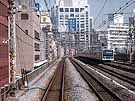
Going up through downtown Tokyo between Shimbashi and
Yurakucho from the front of a north-bound train. In this area, the line
features two double tracks shared with the Yamanote Line, which uses
the inner two tracks. The train on the right is a south-bound
Keihin-Tohoku train.
February 2002.
|
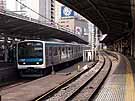
A south-bound rapid train passing through Shimbashi.
February 2002.
|
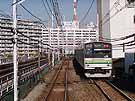
A Yokohama Line's 205 series set rolling down to Sakuragicho
leaving Yokohama station. During off peak hours, some trains from the
Yokohama Line operate over the Negishi Line from Higashi-Kanagawa as
far as Sakuragicho, Isogo and Ofuna.
February 2002.
|
<
P>
An interesting part of the Keihin-Tohoku Line is between Tabata and
Shinagawa in the central part of Tokyo, where the Yamanote Line's
circular service parallels. This segment consists of two double tracks
dedicated to respectively the Keihin-Tohoku and Yamanote Lines. Between
Tabata and Tamachi, the Yamanote Line uses the inner two tracks while
the Keihin-Tohoku Line runs along the outer two tracks so that both
services in the same direction run parallel to each other. At each
station on this section, two island platforms are sandwiched by both
line's tracks going in the same direction, providing an easy transfer
between both services to passengers. This convenient strategy was first
planned just after the full service opening between Sakuragicho and
Omiya in 1932, but due to hardship during the War period, the upgrading
work was disrupted. It was in 1956 when the twin double-track structure
was finally completed, resolving a bottleneck in increasing both
services' operation capacity. Another factor helpful in realizing this
strategy were two crossovers between the two services located north of
Tabata and between Shinagawa and Tamachi, both of which were completed
much earlier, in 1927.
With the advantage of the Yamanote Line running parallel between
Tabata and Tamachi, the Keihin-Tohoku Line trains are operated as a
rapid service on this segment during the day time between 10:00 AM and
15:00 PM. During this time, the Keihin-Tohoku Line trains stop only at
Ueno, Akihabara, and Tokyo. This rapid service was introduced in March
1988 a little while after the JNR was privatized. This service has
become established these days, although there was some confusion in the
early stage. However, you need to be careful when you travel to an
intermediate station from the north or south outside this service
segment during the off-peak time.
Depot:
Nowadays, all stock in the Keihin-Tohoku Line fleet is concentrated at
Urawa depot, but they used to be distributed at four depots, Kamata,
Higashi-Kanagawa, Shimo-Jujo and Urawa. There are Y tracks for return
operation at Ueno, Kamata, Tsurumi, Sakuragicho and Isogo. Sidings for
overnight layover are at Shimo-Jujo (depot), Kamata (depot),
Higashi-Kanagawa (depot), Isogo and Hongodai. Crews are based at those
depots of Urawa, Shimo-Jujo, Kamata and Higashi-Kanagawa. Crew changes
are seen at Minami-Urawa, Shimo-Jujo, Kamata and Higashi-Kanagawa.
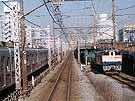 |
|
A freight train emerging to enter the Negishi Line from a
flyover tunnel of the south-bound main track located just north of
Sakuragicho. The train on the left is of the Tokyu Toyoko Line.
February 2002.
|
Signal and Freight Work:
The Keihin-Tohoku Line uses a cab-signaled ATC system, which was
introduced by 1984 (now the line is under process of the replacement of
the ATC with a more advanced system). No wayside signals are seen
alongside the track on the segment north of Sakuragicho except shunting
signals. The Sakuragicho to Ofuna section is installed with wayside
colour light signals, because freight trains share the track.
Particularly up to Negishi from Sakuragicho, fairly active freight work
is seen, because of the existence of an oil refining complex at Negishi
and a freight branch connecting to Honmoku freight station of the
Yokohama Waterfront Railway situated close to Yokohama Port. Tanker
trains and intermodal container trains rumbling along the elevated
track in downtown Yokohama are an interesting feature for railway
enthusiasts.
Recent Major Milestones of the Keihin-Tohoku Line:
- 1965: 103 series was introduced.
- 1972: Obsolete 72 series was completely withdrawn. 10-car
formation was fully achieved with the 103 series along with five 10-car
101 series sets which were supplementarily allocated.
- 1974: New version of the 103 series fitted with air-conditioners and on-board ATC equipment began to be introduced.
- 1984: The introduction of the ATC system was completed on the entire service length.
- 1992: The prototype of the 209 series was put in service.
- 1995: The mass-production version of 209 series was put in service.
- 1998: 103 series was completely withdrawn.
- 2001: A new version of the 209 series featuring a wider car body numbered in the 500s was put in service.
- 2007: E233-1000 series 10-car electrical multiple unit (EMU) enter service
- 2010: 209 series 10-car EMUs completely removed from Keihin-Tōhoku Line service
Summary:
I have long been a daily patron of the Keihin-Tohoku Line since I
settled down in Yokohama with the start of my career. With this
background, I have been seeing the evolution of this service through my
daily rides. My ride is mainly on a southern section between Tsurumi
and Yokodai, commuting for about 30 minutes. When I began to use this
line, the rolling stock in use was 72 series, a reminiscence of old
'Shosen Densha' retaining dignity in its dark maroon livery with
varnished wooden interior. In spite of the line's glorious history, the
status of the line around that time was rather declined against other
major commuter lines, the Chuo Line and the Yamanote Line. The 103
series, categorized as the ex-JNR's high-performance stock following
the 101 series, came rather late to the Keihin-Tohoku Line after these
other lines. The re-signaling with the ATC system was at the same time
as the Yamanote Line, but its benefit was subtle for passengers,
although it was quite innovative from the technological aspect. The
introduction of air-conditioned stock also started several years later
after the Chuo and Yamanote Line, although it was quite thankful in
muggy summers.
No big changes are expected to occur for a while in the near future
on the Keihin-Tohoku Line, but it will continue providing a quite good
quality of service with neat rolling stock of 209 series as well as
reasonable operation frequency.
Continued to Photo Page
Photos were taken by the author unless specified.
[Home Page]


